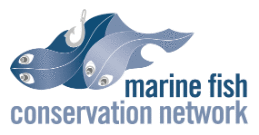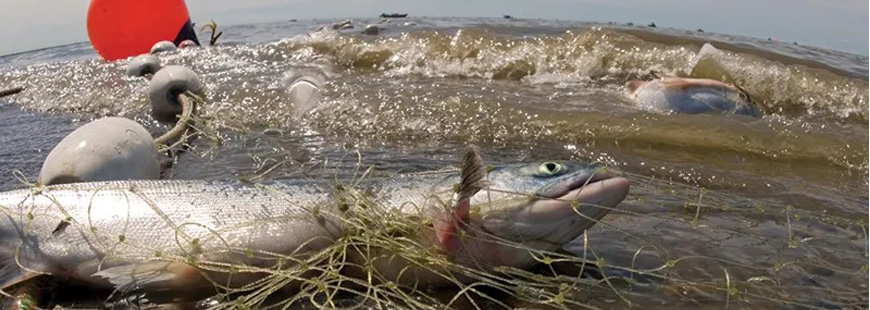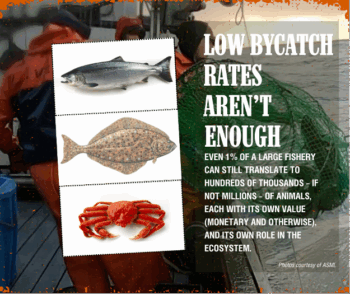This article was originally posted on September 18, 2025 on the Alaska Marine Conservation Council’s blog and is reprinted with permission. Top photo via the Alaska Department of Fish & Game.</p>
Each year, the North Pacific Fishery Management Council (NPFMC) sets the Total Allowable Catch (TAC) for groundfish and other fisheries in the Bering Sea and Gulf of Alaska. TACs are based on stock assessments and aim to ensure the long-term sustainability of the target species. The process is often described as one of the most science-based in the world. However, TAC decisions also affect the amount of bycatch taken, and at today’s harvest levels, that bycatch remains far too high.
So why do we often hear celebration of the “low rate” of bycatch in many of our largest fisheries? That’s because looking at bycatch as a rate can easily make it sound or seem less impactful than it is, particularly when discussing harvests in the billions of pounds. What we need to do is look at totals.
Bycatch reduction efforts have been significant. Fleets, managers, and researchers have invested heavily in reducing it, and the North Pacific has adopted advanced measures such as area closures, real-time hot spot reporting, and gear innovations. These efforts have lowered bycatch rates (aka the percentage of bycatch compared to the target catch), and compared to other regions. North Pacific fisheries are among the best globally. However, percentages only tell one part of the story. Even very low rates equate to tens of thousands of salmon, halibut, crab, and other species being lost each year.
Even 1% of a large fishery can still translate to hundreds of thousands – if not millions – of animals, each with its own value (monetary and otherwise), and its own role in the ecosystem. Salmon support subsistence traditions and commercial livelihoods, halibut sustain small-boat fleets, and crab play critical ecological roles, along with supporting commercial and subsistence efforts. Losing them in large numbers has serious consequences.
Cumulative impacts are also significant. Even if no single year seems disastrous, ongoing losses of specific age groups, sizes, or genetic lines over decades can change the makeup of a species. Salmon returning to their natal rivers carry genetic diversity that helps populations adapt to changing conditions. Tens and sometimes hundreds of thousands are lost each year as bycatch, which erodes this diversity and weakens populations’ ability to withstand warming oceans and shifting ecosystems. Genetic studies of Alaska salmon bycatch highlight these risks and stress the importance of protecting stock diversity (NOAA Fisheries 2023). Yet it’s hard to emphasize the genetic and spawning importance of say 2,000 salmon to one struggling river system when it is presented as a percentage of a different species, or as a small segment of the overall salmon take. We are missing critical information.
The issue spans ecosystems. Removing large quantities of non-target fish and crab impacts predators, changes benthic habitats, and disrupts food webs. TACs are established for each species, but bycatch affects the entire system, challenging ecosystem balance as well as our ability to understand it (Marine Fisheries Review 2020).
Equity is another critical aspect. Bycatch often takes away species that small-boat fishermen and subsistence users depend on, yet these groups have little influence in Council decisions. They don’t harvest in numbers that carry the right political weight, regardless of how important that catch is to their family and community. Industrial fleets responsible for the biggest harvests and the majority of bycatch often receive the most significant opportunities for policy influence. This inequity creates an imbalance that undermines fairness and trust.
Flawed bycatch reporting can also hide impact. Mortality estimates often assume some discarded fish survive, even when studies show higher mortality. For example, halibut released from trawl nets can face mortality rates exceeding 80 percent, significantly higher than official estimates (NOAA Fisheries 2023). Data is often buried in technical reports while percentages are highlighted as progress, leaving communities unaware of the accurate scale of loss.
Some may argue that lowering TACs to reduce bycatch threatens economic viability. While this concern is valid, it overlooks the long-term collective cost of not acting. Every salmon, crab, or halibut lost is one less fish for targeted harvest, one less chance for families depending on fisheries, and one less part of ecosystem resilience. These are not incidental losses; they are real impacts with lasting consequences. Will we ever achieve a zero bycatch fisheries system? No, but we can take steps towards significant improvements.
Meaningful change requires more than just minor progress or mathematical tweaks. Bycatch should be measured as total numbers with attention to long-term effects. The NPFMC has the power to question whether current TAC levels support the sustainability of fisheries, ecosystems, and communities. There are options to better consider the whole ecosystem, protect small-boat and subsistence fisheries, and increase transparency so the actual scale of bycatch is clear. (Pacific States Marine Fisheries Commission 2023).
The NPFMC is well respected for its science-based management. However, cumulative bycatch, ecosystem changes, and climate change are bringing the system closer to a breaking point. The TAC-setting process is one of the Council’s most effective tools to address bycatch. It’s time to use it with the urgency the situation requires.
References
- Marine Fisheries Review. (2020). Fish bycatch in the North Pacific halibut fisheries.
- NOAA Fisheries. (2023a). Halibut discard mortality rates. U.S. Department of Commerce.
- NOAA Fisheries. (2023b). Genetic studies of salmon bycatch. U.S. Department of Commerce.
- Pacific States Marine Fisheries Commission. (2023). Pacific fisheries bycatch program.



